Taxation Law: Income Tax, Capital Gains, and Tax Liability Analysis
VerifiedAdded on 2023/01/16
|10
|2656
|21
Homework Assignment
AI Summary
This assignment delves into the intricacies of Australian taxation law, focusing on assessable income and capital gains tax (CGT). It examines various income sources, including tips, employment income, and gifts, to determine their taxability under the Income Tax Assessment Act (ITAA). The assignment also analyzes capital gains implications on the sale of assets like houses, cars, businesses, furniture, and collectibles, considering exemptions and concessions available under CGT regulations. Through detailed analysis and application of relevant tax provisions, the assignment provides a comprehensive understanding of individual tax obligations and potential tax liabilities in Australia. Desklib provides a platform to access more solved assignments and past papers for students.
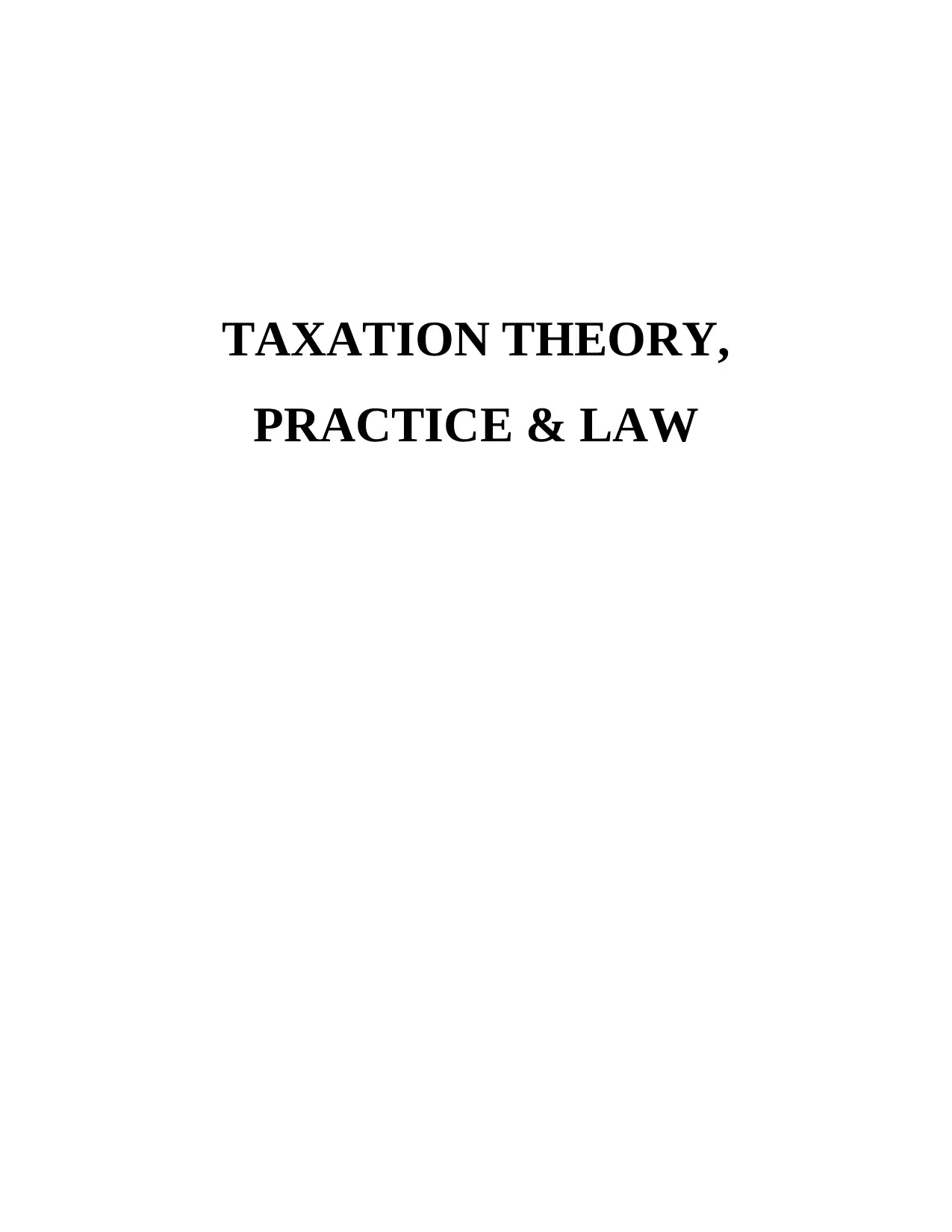
TAXATION THEORY,
PRACTICE & LAW
PRACTICE & LAW
Paraphrase This Document
Need a fresh take? Get an instant paraphrase of this document with our AI Paraphraser
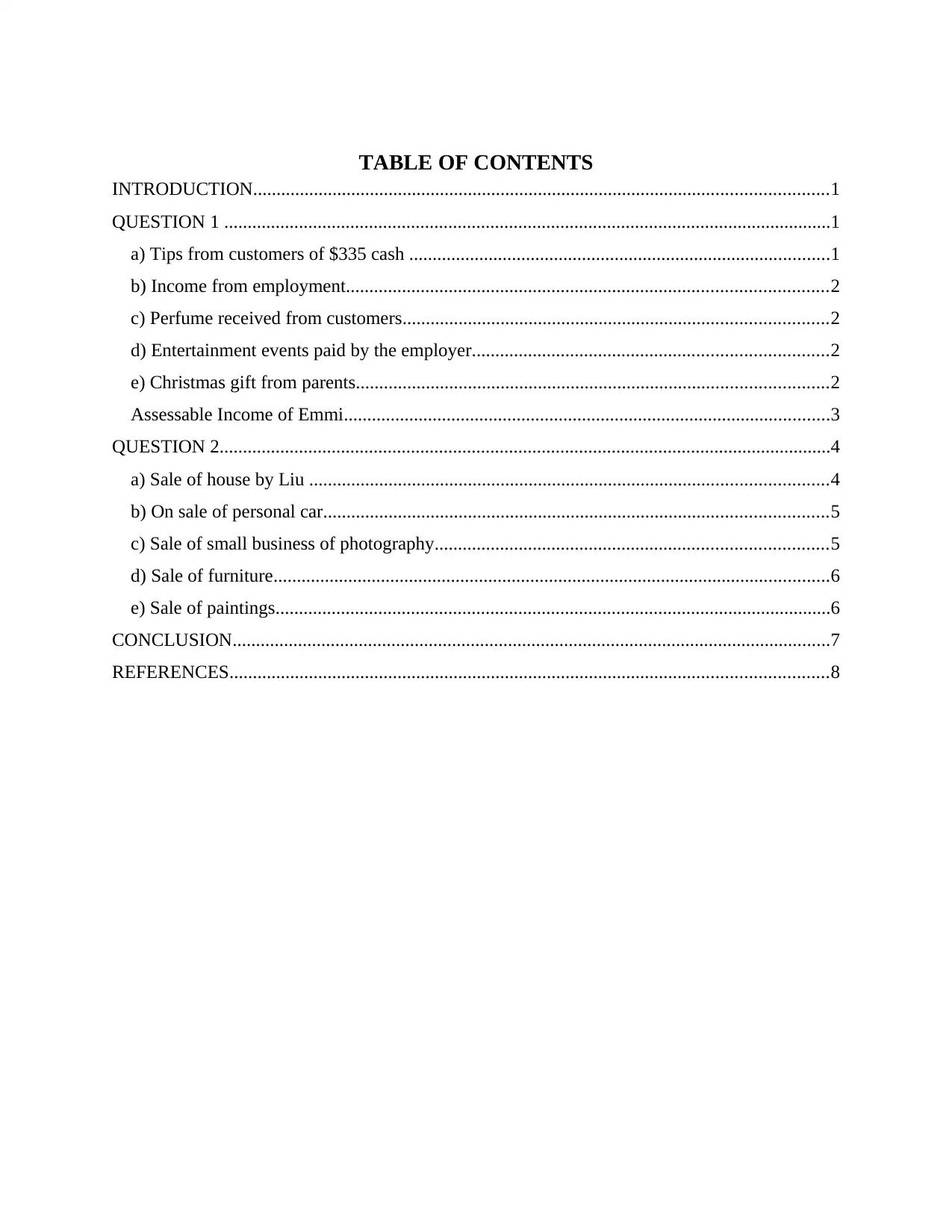
TABLE OF CONTENTS
INTRODUCTION...........................................................................................................................1
QUESTION 1 ..................................................................................................................................1
a) Tips from customers of $335 cash ..........................................................................................1
b) Income from employment.......................................................................................................2
c) Perfume received from customers...........................................................................................2
d) Entertainment events paid by the employer............................................................................2
e) Christmas gift from parents.....................................................................................................2
Assessable Income of Emmi........................................................................................................3
QUESTION 2...................................................................................................................................4
a) Sale of house by Liu ...............................................................................................................4
b) On sale of personal car............................................................................................................5
c) Sale of small business of photography....................................................................................5
d) Sale of furniture.......................................................................................................................6
e) Sale of paintings.......................................................................................................................6
CONCLUSION................................................................................................................................7
REFERENCES................................................................................................................................8
INTRODUCTION...........................................................................................................................1
QUESTION 1 ..................................................................................................................................1
a) Tips from customers of $335 cash ..........................................................................................1
b) Income from employment.......................................................................................................2
c) Perfume received from customers...........................................................................................2
d) Entertainment events paid by the employer............................................................................2
e) Christmas gift from parents.....................................................................................................2
Assessable Income of Emmi........................................................................................................3
QUESTION 2...................................................................................................................................4
a) Sale of house by Liu ...............................................................................................................4
b) On sale of personal car............................................................................................................5
c) Sale of small business of photography....................................................................................5
d) Sale of furniture.......................................................................................................................6
e) Sale of paintings.......................................................................................................................6
CONCLUSION................................................................................................................................7
REFERENCES................................................................................................................................8
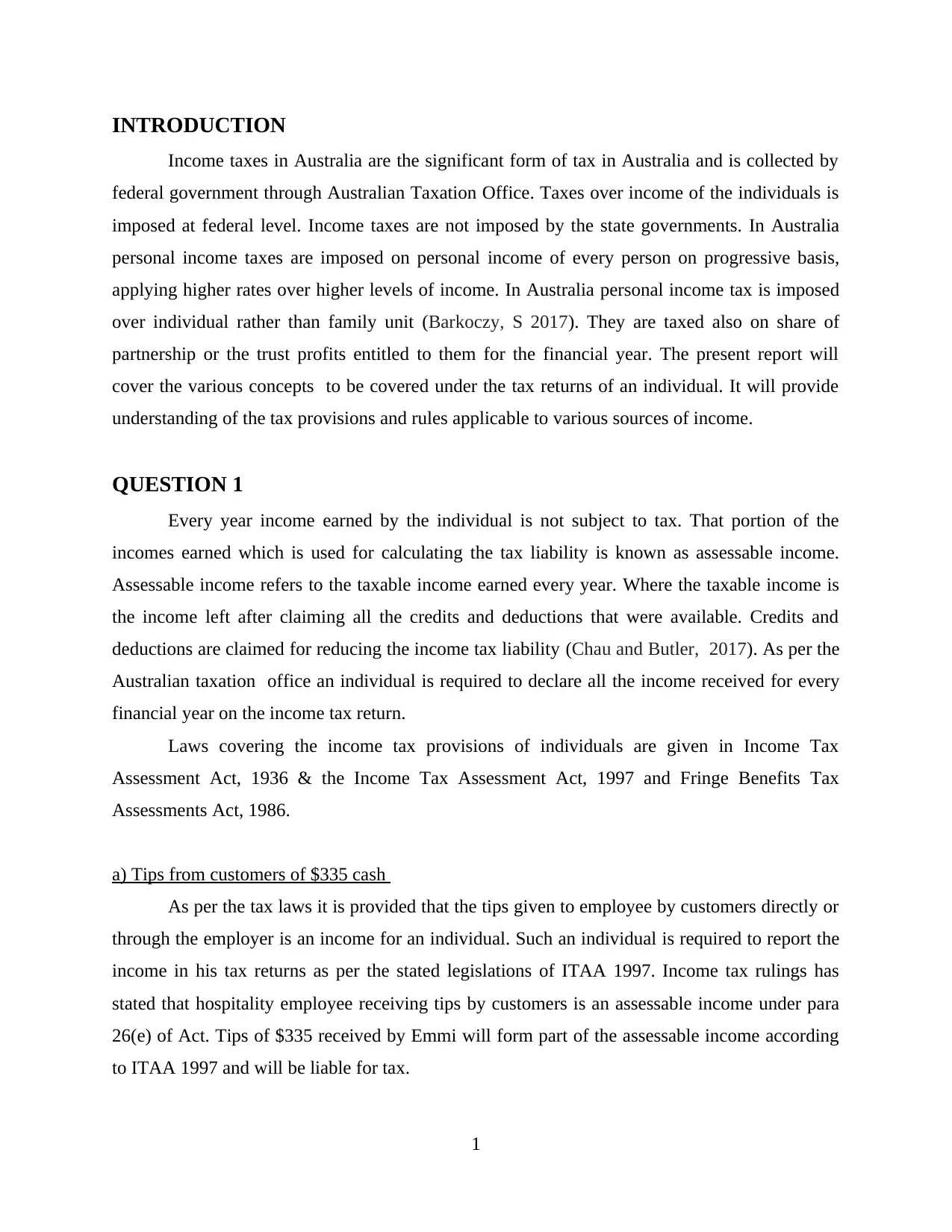
INTRODUCTION
Income taxes in Australia are the significant form of tax in Australia and is collected by
federal government through Australian Taxation Office. Taxes over income of the individuals is
imposed at federal level. Income taxes are not imposed by the state governments. In Australia
personal income taxes are imposed on personal income of every person on progressive basis,
applying higher rates over higher levels of income. In Australia personal income tax is imposed
over individual rather than family unit (Barkoczy, S 2017). They are taxed also on share of
partnership or the trust profits entitled to them for the financial year. The present report will
cover the various concepts to be covered under the tax returns of an individual. It will provide
understanding of the tax provisions and rules applicable to various sources of income.
QUESTION 1
Every year income earned by the individual is not subject to tax. That portion of the
incomes earned which is used for calculating the tax liability is known as assessable income.
Assessable income refers to the taxable income earned every year. Where the taxable income is
the income left after claiming all the credits and deductions that were available. Credits and
deductions are claimed for reducing the income tax liability (Chau and Butler, 2017). As per the
Australian taxation office an individual is required to declare all the income received for every
financial year on the income tax return.
Laws covering the income tax provisions of individuals are given in Income Tax
Assessment Act, 1936 & the Income Tax Assessment Act, 1997 and Fringe Benefits Tax
Assessments Act, 1986.
a) Tips from customers of $335 cash
As per the tax laws it is provided that the tips given to employee by customers directly or
through the employer is an income for an individual. Such an individual is required to report the
income in his tax returns as per the stated legislations of ITAA 1997. Income tax rulings has
stated that hospitality employee receiving tips by customers is an assessable income under para
26(e) of Act. Tips of $335 received by Emmi will form part of the assessable income according
to ITAA 1997 and will be liable for tax.
1
Income taxes in Australia are the significant form of tax in Australia and is collected by
federal government through Australian Taxation Office. Taxes over income of the individuals is
imposed at federal level. Income taxes are not imposed by the state governments. In Australia
personal income taxes are imposed on personal income of every person on progressive basis,
applying higher rates over higher levels of income. In Australia personal income tax is imposed
over individual rather than family unit (Barkoczy, S 2017). They are taxed also on share of
partnership or the trust profits entitled to them for the financial year. The present report will
cover the various concepts to be covered under the tax returns of an individual. It will provide
understanding of the tax provisions and rules applicable to various sources of income.
QUESTION 1
Every year income earned by the individual is not subject to tax. That portion of the
incomes earned which is used for calculating the tax liability is known as assessable income.
Assessable income refers to the taxable income earned every year. Where the taxable income is
the income left after claiming all the credits and deductions that were available. Credits and
deductions are claimed for reducing the income tax liability (Chau and Butler, 2017). As per the
Australian taxation office an individual is required to declare all the income received for every
financial year on the income tax return.
Laws covering the income tax provisions of individuals are given in Income Tax
Assessment Act, 1936 & the Income Tax Assessment Act, 1997 and Fringe Benefits Tax
Assessments Act, 1986.
a) Tips from customers of $335 cash
As per the tax laws it is provided that the tips given to employee by customers directly or
through the employer is an income for an individual. Such an individual is required to report the
income in his tax returns as per the stated legislations of ITAA 1997. Income tax rulings has
stated that hospitality employee receiving tips by customers is an assessable income under para
26(e) of Act. Tips of $335 received by Emmi will form part of the assessable income according
to ITAA 1997 and will be liable for tax.
1
⊘ This is a preview!⊘
Do you want full access?
Subscribe today to unlock all pages.

Trusted by 1+ million students worldwide
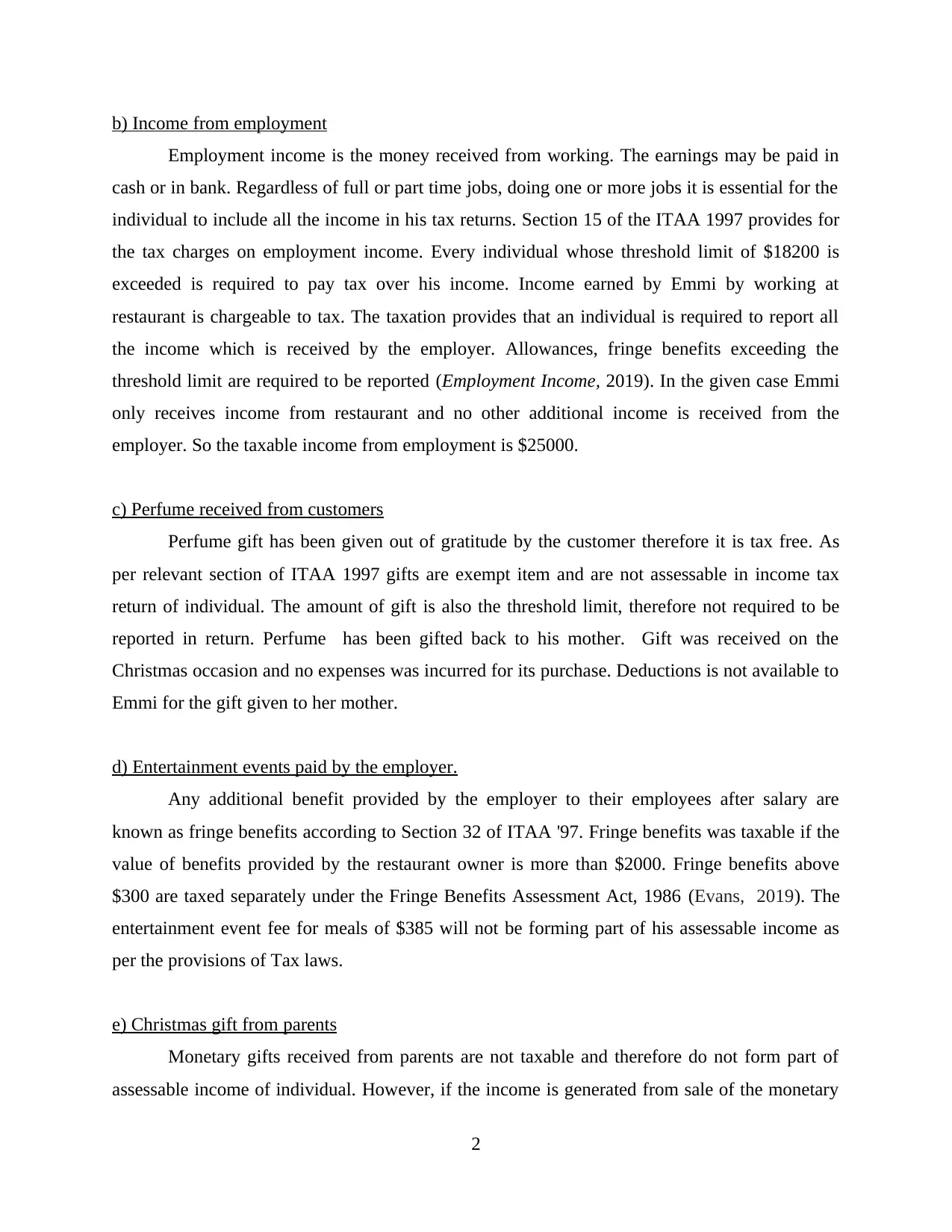
b) Income from employment
Employment income is the money received from working. The earnings may be paid in
cash or in bank. Regardless of full or part time jobs, doing one or more jobs it is essential for the
individual to include all the income in his tax returns. Section 15 of the ITAA 1997 provides for
the tax charges on employment income. Every individual whose threshold limit of $18200 is
exceeded is required to pay tax over his income. Income earned by Emmi by working at
restaurant is chargeable to tax. The taxation provides that an individual is required to report all
the income which is received by the employer. Allowances, fringe benefits exceeding the
threshold limit are required to be reported (Employment Income, 2019). In the given case Emmi
only receives income from restaurant and no other additional income is received from the
employer. So the taxable income from employment is $25000.
c) Perfume received from customers
Perfume gift has been given out of gratitude by the customer therefore it is tax free. As
per relevant section of ITAA 1997 gifts are exempt item and are not assessable in income tax
return of individual. The amount of gift is also the threshold limit, therefore not required to be
reported in return. Perfume has been gifted back to his mother. Gift was received on the
Christmas occasion and no expenses was incurred for its purchase. Deductions is not available to
Emmi for the gift given to her mother.
d) Entertainment events paid by the employer.
Any additional benefit provided by the employer to their employees after salary are
known as fringe benefits according to Section 32 of ITAA '97. Fringe benefits was taxable if the
value of benefits provided by the restaurant owner is more than $2000. Fringe benefits above
$300 are taxed separately under the Fringe Benefits Assessment Act, 1986 (Evans, 2019). The
entertainment event fee for meals of $385 will not be forming part of his assessable income as
per the provisions of Tax laws.
e) Christmas gift from parents
Monetary gifts received from parents are not taxable and therefore do not form part of
assessable income of individual. However, if the income is generated from sale of the monetary
2
Employment income is the money received from working. The earnings may be paid in
cash or in bank. Regardless of full or part time jobs, doing one or more jobs it is essential for the
individual to include all the income in his tax returns. Section 15 of the ITAA 1997 provides for
the tax charges on employment income. Every individual whose threshold limit of $18200 is
exceeded is required to pay tax over his income. Income earned by Emmi by working at
restaurant is chargeable to tax. The taxation provides that an individual is required to report all
the income which is received by the employer. Allowances, fringe benefits exceeding the
threshold limit are required to be reported (Employment Income, 2019). In the given case Emmi
only receives income from restaurant and no other additional income is received from the
employer. So the taxable income from employment is $25000.
c) Perfume received from customers
Perfume gift has been given out of gratitude by the customer therefore it is tax free. As
per relevant section of ITAA 1997 gifts are exempt item and are not assessable in income tax
return of individual. The amount of gift is also the threshold limit, therefore not required to be
reported in return. Perfume has been gifted back to his mother. Gift was received on the
Christmas occasion and no expenses was incurred for its purchase. Deductions is not available to
Emmi for the gift given to her mother.
d) Entertainment events paid by the employer.
Any additional benefit provided by the employer to their employees after salary are
known as fringe benefits according to Section 32 of ITAA '97. Fringe benefits was taxable if the
value of benefits provided by the restaurant owner is more than $2000. Fringe benefits above
$300 are taxed separately under the Fringe Benefits Assessment Act, 1986 (Evans, 2019). The
entertainment event fee for meals of $385 will not be forming part of his assessable income as
per the provisions of Tax laws.
e) Christmas gift from parents
Monetary gifts received from parents are not taxable and therefore do not form part of
assessable income of individual. However, if the income is generated from sale of the monetary
2
Paraphrase This Document
Need a fresh take? Get an instant paraphrase of this document with our AI Paraphraser
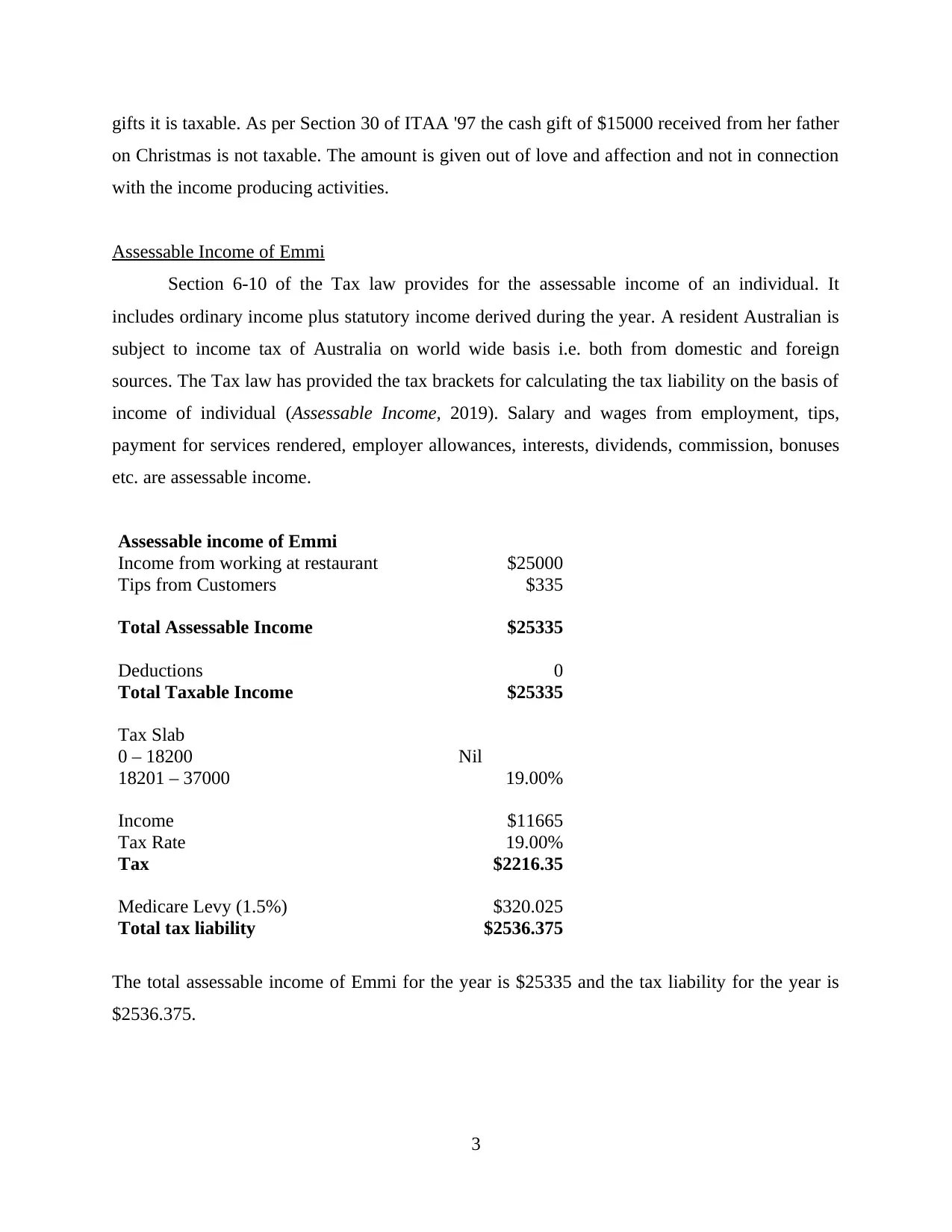
gifts it is taxable. As per Section 30 of ITAA '97 the cash gift of $15000 received from her father
on Christmas is not taxable. The amount is given out of love and affection and not in connection
with the income producing activities.
Assessable Income of Emmi
Section 6-10 of the Tax law provides for the assessable income of an individual. It
includes ordinary income plus statutory income derived during the year. A resident Australian is
subject to income tax of Australia on world wide basis i.e. both from domestic and foreign
sources. The Tax law has provided the tax brackets for calculating the tax liability on the basis of
income of individual (Assessable Income, 2019). Salary and wages from employment, tips,
payment for services rendered, employer allowances, interests, dividends, commission, bonuses
etc. are assessable income.
Assessable income of Emmi
Income from working at restaurant $25000
Tips from Customers $335
Total Assessable Income $25335
Deductions 0
Total Taxable Income $25335
Tax Slab
0 – 18200 Nil
18201 – 37000 19.00%
Income $11665
Tax Rate 19.00%
Tax $2216.35
Medicare Levy (1.5%) $320.025
Total tax liability $2536.375
The total assessable income of Emmi for the year is $25335 and the tax liability for the year is
$2536.375.
3
on Christmas is not taxable. The amount is given out of love and affection and not in connection
with the income producing activities.
Assessable Income of Emmi
Section 6-10 of the Tax law provides for the assessable income of an individual. It
includes ordinary income plus statutory income derived during the year. A resident Australian is
subject to income tax of Australia on world wide basis i.e. both from domestic and foreign
sources. The Tax law has provided the tax brackets for calculating the tax liability on the basis of
income of individual (Assessable Income, 2019). Salary and wages from employment, tips,
payment for services rendered, employer allowances, interests, dividends, commission, bonuses
etc. are assessable income.
Assessable income of Emmi
Income from working at restaurant $25000
Tips from Customers $335
Total Assessable Income $25335
Deductions 0
Total Taxable Income $25335
Tax Slab
0 – 18200 Nil
18201 – 37000 19.00%
Income $11665
Tax Rate 19.00%
Tax $2216.35
Medicare Levy (1.5%) $320.025
Total tax liability $2536.375
The total assessable income of Emmi for the year is $25335 and the tax liability for the year is
$2536.375.
3
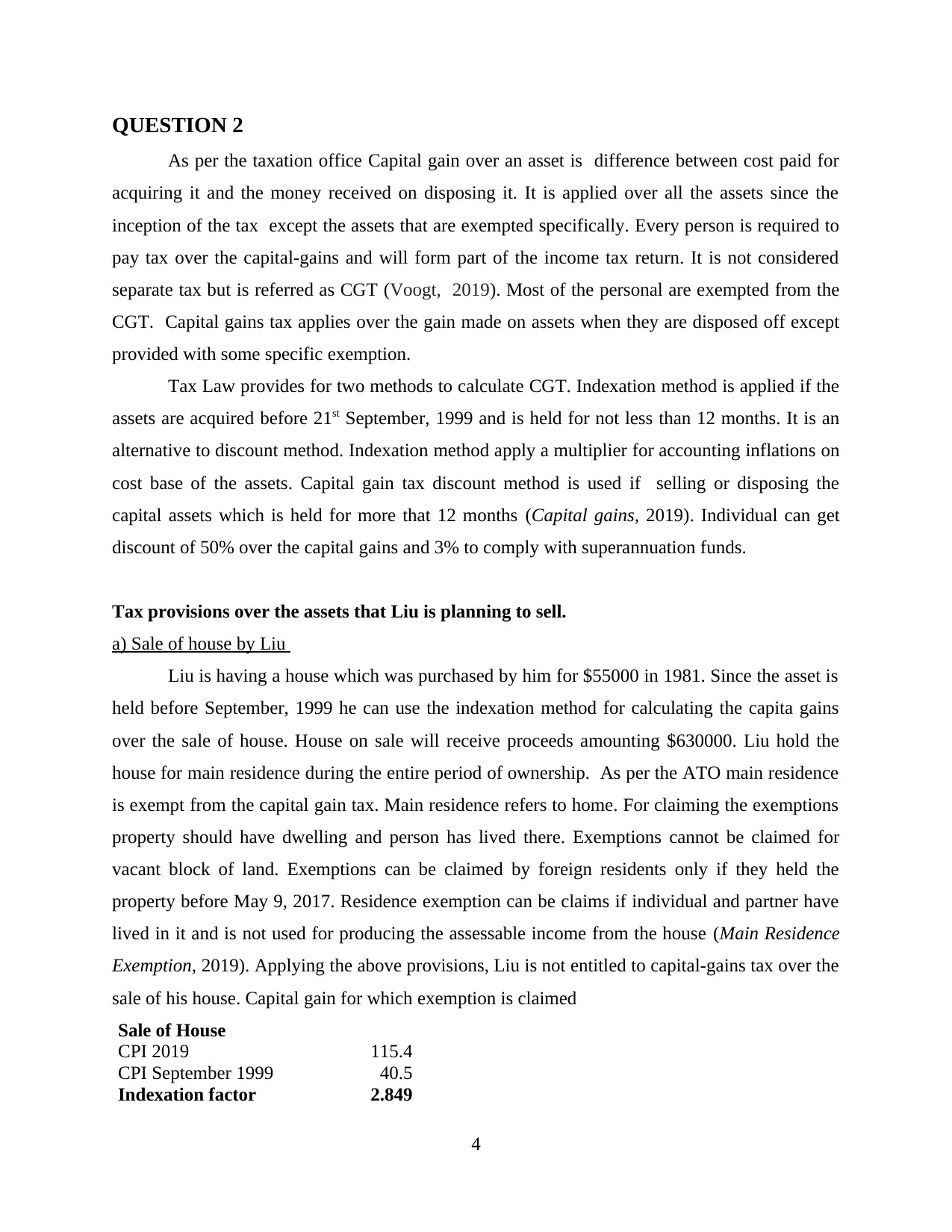
QUESTION 2
As per the taxation office Capital gain over an asset is difference between cost paid for
acquiring it and the money received on disposing it. It is applied over all the assets since the
inception of the tax except the assets that are exempted specifically. Every person is required to
pay tax over the capital-gains and will form part of the income tax return. It is not considered
separate tax but is referred as CGT (Voogt, 2019). Most of the personal are exempted from the
CGT. Capital gains tax applies over the gain made on assets when they are disposed off except
provided with some specific exemption.
Tax Law provides for two methods to calculate CGT. Indexation method is applied if the
assets are acquired before 21st September, 1999 and is held for not less than 12 months. It is an
alternative to discount method. Indexation method apply a multiplier for accounting inflations on
cost base of the assets. Capital gain tax discount method is used if selling or disposing the
capital assets which is held for more that 12 months (Capital gains, 2019). Individual can get
discount of 50% over the capital gains and 3% to comply with superannuation funds.
Tax provisions over the assets that Liu is planning to sell.
a) Sale of house by Liu
Liu is having a house which was purchased by him for $55000 in 1981. Since the asset is
held before September, 1999 he can use the indexation method for calculating the capita gains
over the sale of house. House on sale will receive proceeds amounting $630000. Liu hold the
house for main residence during the entire period of ownership. As per the ATO main residence
is exempt from the capital gain tax. Main residence refers to home. For claiming the exemptions
property should have dwelling and person has lived there. Exemptions cannot be claimed for
vacant block of land. Exemptions can be claimed by foreign residents only if they held the
property before May 9, 2017. Residence exemption can be claims if individual and partner have
lived in it and is not used for producing the assessable income from the house (Main Residence
Exemption, 2019). Applying the above provisions, Liu is not entitled to capital-gains tax over the
sale of his house. Capital gain for which exemption is claimed
Sale of House
CPI 2019 115.4
CPI September 1999 40.5
Indexation factor 2.849
4
As per the taxation office Capital gain over an asset is difference between cost paid for
acquiring it and the money received on disposing it. It is applied over all the assets since the
inception of the tax except the assets that are exempted specifically. Every person is required to
pay tax over the capital-gains and will form part of the income tax return. It is not considered
separate tax but is referred as CGT (Voogt, 2019). Most of the personal are exempted from the
CGT. Capital gains tax applies over the gain made on assets when they are disposed off except
provided with some specific exemption.
Tax Law provides for two methods to calculate CGT. Indexation method is applied if the
assets are acquired before 21st September, 1999 and is held for not less than 12 months. It is an
alternative to discount method. Indexation method apply a multiplier for accounting inflations on
cost base of the assets. Capital gain tax discount method is used if selling or disposing the
capital assets which is held for more that 12 months (Capital gains, 2019). Individual can get
discount of 50% over the capital gains and 3% to comply with superannuation funds.
Tax provisions over the assets that Liu is planning to sell.
a) Sale of house by Liu
Liu is having a house which was purchased by him for $55000 in 1981. Since the asset is
held before September, 1999 he can use the indexation method for calculating the capita gains
over the sale of house. House on sale will receive proceeds amounting $630000. Liu hold the
house for main residence during the entire period of ownership. As per the ATO main residence
is exempt from the capital gain tax. Main residence refers to home. For claiming the exemptions
property should have dwelling and person has lived there. Exemptions cannot be claimed for
vacant block of land. Exemptions can be claimed by foreign residents only if they held the
property before May 9, 2017. Residence exemption can be claims if individual and partner have
lived in it and is not used for producing the assessable income from the house (Main Residence
Exemption, 2019). Applying the above provisions, Liu is not entitled to capital-gains tax over the
sale of his house. Capital gain for which exemption is claimed
Sale of House
CPI 2019 115.4
CPI September 1999 40.5
Indexation factor 2.849
4
⊘ This is a preview!⊘
Do you want full access?
Subscribe today to unlock all pages.

Trusted by 1+ million students worldwide
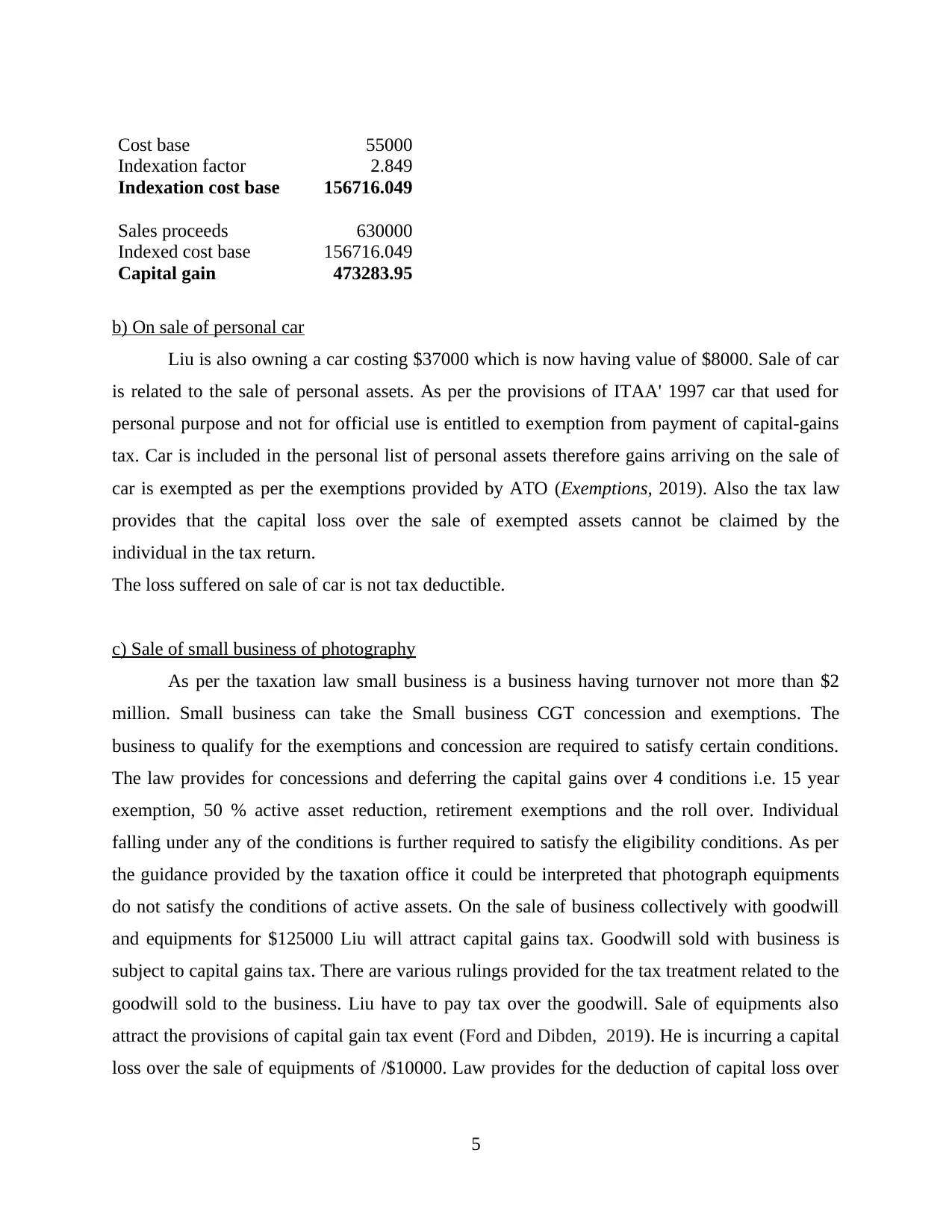
Cost base 55000
Indexation factor 2.849
Indexation cost base 156716.049
Sales proceeds 630000
Indexed cost base 156716.049
Capital gain 473283.95
b) On sale of personal car
Liu is also owning a car costing $37000 which is now having value of $8000. Sale of car
is related to the sale of personal assets. As per the provisions of ITAA' 1997 car that used for
personal purpose and not for official use is entitled to exemption from payment of capital-gains
tax. Car is included in the personal list of personal assets therefore gains arriving on the sale of
car is exempted as per the exemptions provided by ATO (Exemptions, 2019). Also the tax law
provides that the capital loss over the sale of exempted assets cannot be claimed by the
individual in the tax return.
The loss suffered on sale of car is not tax deductible.
c) Sale of small business of photography
As per the taxation law small business is a business having turnover not more than $2
million. Small business can take the Small business CGT concession and exemptions. The
business to qualify for the exemptions and concession are required to satisfy certain conditions.
The law provides for concessions and deferring the capital gains over 4 conditions i.e. 15 year
exemption, 50 % active asset reduction, retirement exemptions and the roll over. Individual
falling under any of the conditions is further required to satisfy the eligibility conditions. As per
the guidance provided by the taxation office it could be interpreted that photograph equipments
do not satisfy the conditions of active assets. On the sale of business collectively with goodwill
and equipments for $125000 Liu will attract capital gains tax. Goodwill sold with business is
subject to capital gains tax. There are various rulings provided for the tax treatment related to the
goodwill sold to the business. Liu have to pay tax over the goodwill. Sale of equipments also
attract the provisions of capital gain tax event (Ford and Dibden, 2019). He is incurring a capital
loss over the sale of equipments of /$10000. Law provides for the deduction of capital loss over
5
Indexation factor 2.849
Indexation cost base 156716.049
Sales proceeds 630000
Indexed cost base 156716.049
Capital gain 473283.95
b) On sale of personal car
Liu is also owning a car costing $37000 which is now having value of $8000. Sale of car
is related to the sale of personal assets. As per the provisions of ITAA' 1997 car that used for
personal purpose and not for official use is entitled to exemption from payment of capital-gains
tax. Car is included in the personal list of personal assets therefore gains arriving on the sale of
car is exempted as per the exemptions provided by ATO (Exemptions, 2019). Also the tax law
provides that the capital loss over the sale of exempted assets cannot be claimed by the
individual in the tax return.
The loss suffered on sale of car is not tax deductible.
c) Sale of small business of photography
As per the taxation law small business is a business having turnover not more than $2
million. Small business can take the Small business CGT concession and exemptions. The
business to qualify for the exemptions and concession are required to satisfy certain conditions.
The law provides for concessions and deferring the capital gains over 4 conditions i.e. 15 year
exemption, 50 % active asset reduction, retirement exemptions and the roll over. Individual
falling under any of the conditions is further required to satisfy the eligibility conditions. As per
the guidance provided by the taxation office it could be interpreted that photograph equipments
do not satisfy the conditions of active assets. On the sale of business collectively with goodwill
and equipments for $125000 Liu will attract capital gains tax. Goodwill sold with business is
subject to capital gains tax. There are various rulings provided for the tax treatment related to the
goodwill sold to the business. Liu have to pay tax over the goodwill. Sale of equipments also
attract the provisions of capital gain tax event (Ford and Dibden, 2019). He is incurring a capital
loss over the sale of equipments of /$10000. Law provides for the deduction of capital loss over
5
Paraphrase This Document
Need a fresh take? Get an instant paraphrase of this document with our AI Paraphraser
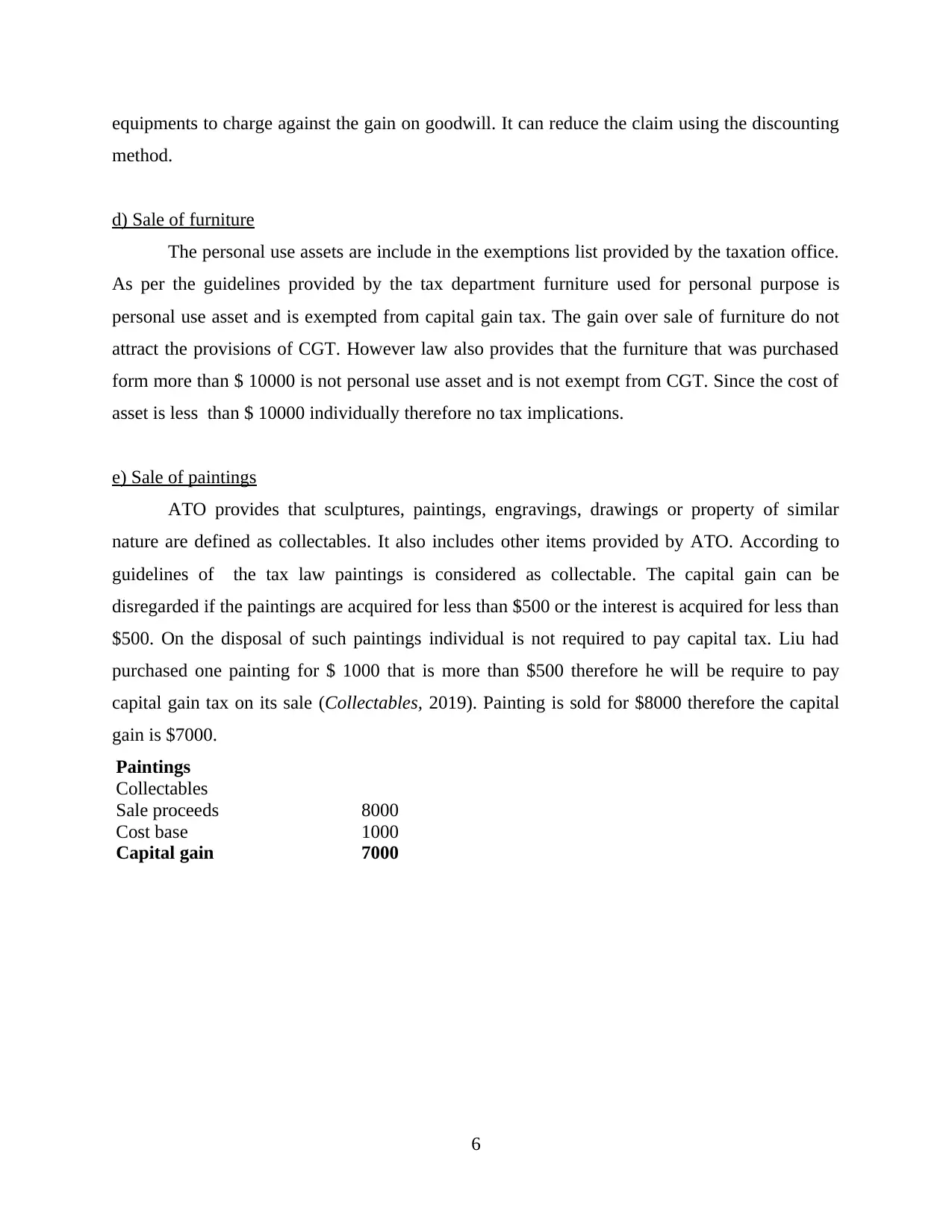
equipments to charge against the gain on goodwill. It can reduce the claim using the discounting
method.
d) Sale of furniture
The personal use assets are include in the exemptions list provided by the taxation office.
As per the guidelines provided by the tax department furniture used for personal purpose is
personal use asset and is exempted from capital gain tax. The gain over sale of furniture do not
attract the provisions of CGT. However law also provides that the furniture that was purchased
form more than $ 10000 is not personal use asset and is not exempt from CGT. Since the cost of
asset is less than $ 10000 individually therefore no tax implications.
e) Sale of paintings
ATO provides that sculptures, paintings, engravings, drawings or property of similar
nature are defined as collectables. It also includes other items provided by ATO. According to
guidelines of the tax law paintings is considered as collectable. The capital gain can be
disregarded if the paintings are acquired for less than $500 or the interest is acquired for less than
$500. On the disposal of such paintings individual is not required to pay capital tax. Liu had
purchased one painting for $ 1000 that is more than $500 therefore he will be require to pay
capital gain tax on its sale (Collectables, 2019). Painting is sold for $8000 therefore the capital
gain is $7000.
Paintings
Collectables
Sale proceeds 8000
Cost base 1000
Capital gain 7000
6
method.
d) Sale of furniture
The personal use assets are include in the exemptions list provided by the taxation office.
As per the guidelines provided by the tax department furniture used for personal purpose is
personal use asset and is exempted from capital gain tax. The gain over sale of furniture do not
attract the provisions of CGT. However law also provides that the furniture that was purchased
form more than $ 10000 is not personal use asset and is not exempt from CGT. Since the cost of
asset is less than $ 10000 individually therefore no tax implications.
e) Sale of paintings
ATO provides that sculptures, paintings, engravings, drawings or property of similar
nature are defined as collectables. It also includes other items provided by ATO. According to
guidelines of the tax law paintings is considered as collectable. The capital gain can be
disregarded if the paintings are acquired for less than $500 or the interest is acquired for less than
$500. On the disposal of such paintings individual is not required to pay capital tax. Liu had
purchased one painting for $ 1000 that is more than $500 therefore he will be require to pay
capital gain tax on its sale (Collectables, 2019). Painting is sold for $8000 therefore the capital
gain is $7000.
Paintings
Collectables
Sale proceeds 8000
Cost base 1000
Capital gain 7000
6
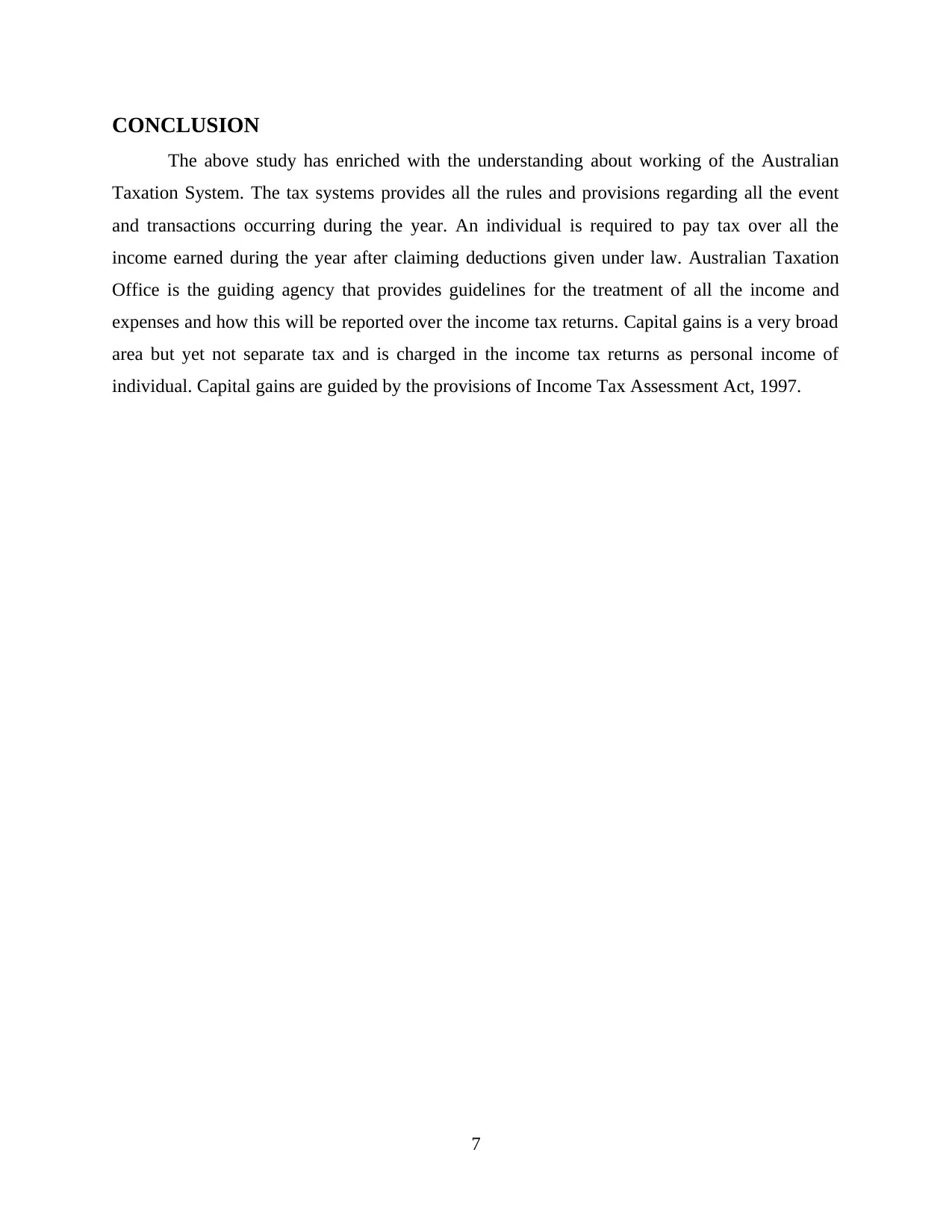
CONCLUSION
The above study has enriched with the understanding about working of the Australian
Taxation System. The tax systems provides all the rules and provisions regarding all the event
and transactions occurring during the year. An individual is required to pay tax over all the
income earned during the year after claiming deductions given under law. Australian Taxation
Office is the guiding agency that provides guidelines for the treatment of all the income and
expenses and how this will be reported over the income tax returns. Capital gains is a very broad
area but yet not separate tax and is charged in the income tax returns as personal income of
individual. Capital gains are guided by the provisions of Income Tax Assessment Act, 1997.
7
The above study has enriched with the understanding about working of the Australian
Taxation System. The tax systems provides all the rules and provisions regarding all the event
and transactions occurring during the year. An individual is required to pay tax over all the
income earned during the year after claiming deductions given under law. Australian Taxation
Office is the guiding agency that provides guidelines for the treatment of all the income and
expenses and how this will be reported over the income tax returns. Capital gains is a very broad
area but yet not separate tax and is charged in the income tax returns as personal income of
individual. Capital gains are guided by the provisions of Income Tax Assessment Act, 1997.
7
⊘ This is a preview!⊘
Do you want full access?
Subscribe today to unlock all pages.

Trusted by 1+ million students worldwide
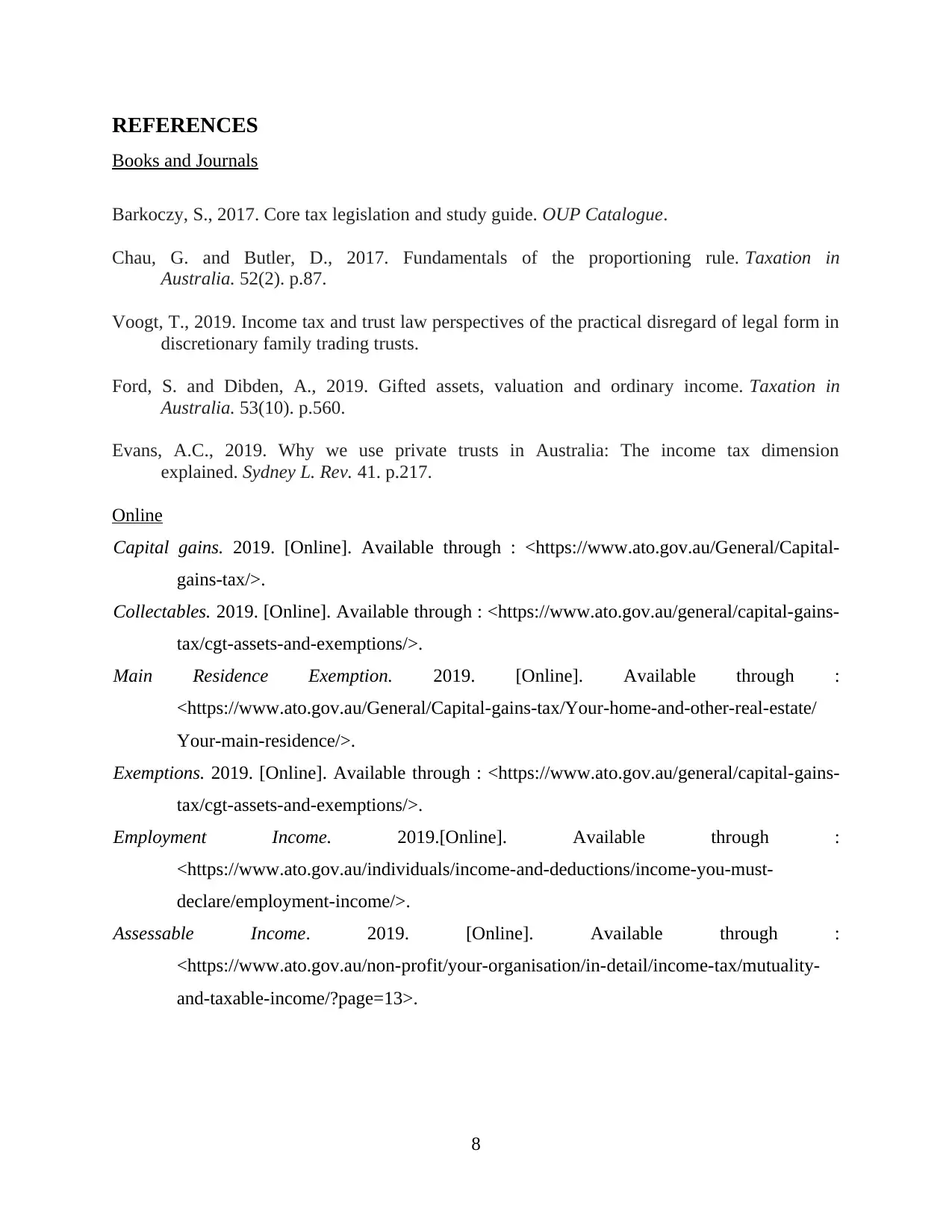
REFERENCES
Books and Journals
Barkoczy, S., 2017. Core tax legislation and study guide. OUP Catalogue.
Chau, G. and Butler, D., 2017. Fundamentals of the proportioning rule. Taxation in
Australia. 52(2). p.87.
Voogt, T., 2019. Income tax and trust law perspectives of the practical disregard of legal form in
discretionary family trading trusts.
Ford, S. and Dibden, A., 2019. Gifted assets, valuation and ordinary income. Taxation in
Australia. 53(10). p.560.
Evans, A.C., 2019. Why we use private trusts in Australia: The income tax dimension
explained. Sydney L. Rev. 41. p.217.
Online
Capital gains. 2019. [Online]. Available through : <https://www.ato.gov.au/General/Capital-
gains-tax/>.
Collectables. 2019. [Online]. Available through : <https://www.ato.gov.au/general/capital-gains-
tax/cgt-assets-and-exemptions/>.
Main Residence Exemption. 2019. [Online]. Available through :
<https://www.ato.gov.au/General/Capital-gains-tax/Your-home-and-other-real-estate/
Your-main-residence/>.
Exemptions. 2019. [Online]. Available through : <https://www.ato.gov.au/general/capital-gains-
tax/cgt-assets-and-exemptions/>.
Employment Income. 2019.[Online]. Available through :
<https://www.ato.gov.au/individuals/income-and-deductions/income-you-must-
declare/employment-income/>.
Assessable Income. 2019. [Online]. Available through :
<https://www.ato.gov.au/non-profit/your-organisation/in-detail/income-tax/mutuality-
and-taxable-income/?page=13>.
8
Books and Journals
Barkoczy, S., 2017. Core tax legislation and study guide. OUP Catalogue.
Chau, G. and Butler, D., 2017. Fundamentals of the proportioning rule. Taxation in
Australia. 52(2). p.87.
Voogt, T., 2019. Income tax and trust law perspectives of the practical disregard of legal form in
discretionary family trading trusts.
Ford, S. and Dibden, A., 2019. Gifted assets, valuation and ordinary income. Taxation in
Australia. 53(10). p.560.
Evans, A.C., 2019. Why we use private trusts in Australia: The income tax dimension
explained. Sydney L. Rev. 41. p.217.
Online
Capital gains. 2019. [Online]. Available through : <https://www.ato.gov.au/General/Capital-
gains-tax/>.
Collectables. 2019. [Online]. Available through : <https://www.ato.gov.au/general/capital-gains-
tax/cgt-assets-and-exemptions/>.
Main Residence Exemption. 2019. [Online]. Available through :
<https://www.ato.gov.au/General/Capital-gains-tax/Your-home-and-other-real-estate/
Your-main-residence/>.
Exemptions. 2019. [Online]. Available through : <https://www.ato.gov.au/general/capital-gains-
tax/cgt-assets-and-exemptions/>.
Employment Income. 2019.[Online]. Available through :
<https://www.ato.gov.au/individuals/income-and-deductions/income-you-must-
declare/employment-income/>.
Assessable Income. 2019. [Online]. Available through :
<https://www.ato.gov.au/non-profit/your-organisation/in-detail/income-tax/mutuality-
and-taxable-income/?page=13>.
8
1 out of 10
Related Documents
Your All-in-One AI-Powered Toolkit for Academic Success.
+13062052269
info@desklib.com
Available 24*7 on WhatsApp / Email
![[object Object]](/_next/static/media/star-bottom.7253800d.svg)
Unlock your academic potential
Copyright © 2020–2025 A2Z Services. All Rights Reserved. Developed and managed by ZUCOL.





